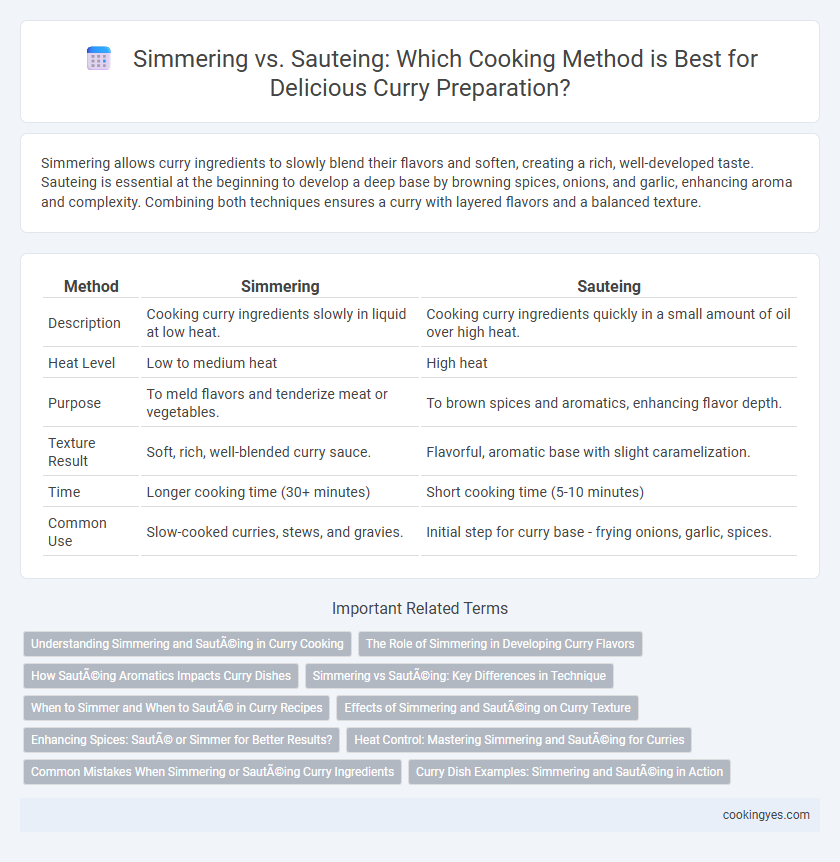Simmering allows curry ingredients to slowly blend their flavors and soften, creating a rich, well-developed taste. Sauteing is essential at the beginning to develop a deep base by browning spices, onions, and garlic, enhancing aroma and complexity. Combining both techniques ensures a curry with layered flavors and a balanced texture.
Table of Comparison
| Method | Simmering | Sauteing |
|---|---|---|
| Description | Cooking curry ingredients slowly in liquid at low heat. | Cooking curry ingredients quickly in a small amount of oil over high heat. |
| Heat Level | Low to medium heat | High heat |
| Purpose | To meld flavors and tenderize meat or vegetables. | To brown spices and aromatics, enhancing flavor depth. |
| Texture Result | Soft, rich, well-blended curry sauce. | Flavorful, aromatic base with slight caramelization. |
| Time | Longer cooking time (30+ minutes) | Short cooking time (5-10 minutes) |
| Common Use | Slow-cooked curries, stews, and gravies. | Initial step for curry base - frying onions, garlic, spices. |
Understanding Simmering and Sautéing in Curry Cooking
Simmering in curry preparation involves cooking ingredients gently in liquid at a low temperature, allowing spices and flavors to meld deeply and develop a rich, complex taste. Sauteing, on the other hand, uses high heat to quickly cook spices and aromatics, releasing essential oils and intensifying their fragrance before liquids are added. Mastering the balance of sauteing spices first and then simmering the curry ensures optimal flavor extraction and texture in traditional Indian and Thai curry dishes.
The Role of Simmering in Developing Curry Flavors
Simmering plays a crucial role in developing curry flavors by allowing spices and ingredients to meld gently over low heat, which enhances depth and richness. Unlike sauteing, which quickly browns spices and aromatics to release initial flavors, simmering extracts and blends complex taste profiles, creating a harmonious and well-rounded curry. Prolonged simmering breaks down tough ingredients like meat and legumes, resulting in tender textures and intensified savory notes.
How Sautéing Aromatics Impacts Curry Dishes
Sauteing aromatics such as onions, garlic, and ginger in curry preparation intensifies flavor by releasing essential oils and caramelizing sugars, creating a rich and complex base. This technique enhances the depth and aroma of the curry, contributing to a more robust and layered taste profile. Proper sauteing improves the overall texture and ensures that spices dissolve evenly, elevating the dish's sensory experience.
Simmering vs Sautéing: Key Differences in Technique
Simmering involves cooking curry at a low, consistent heat where tiny bubbles gently rise, allowing spices to meld and flavors to deepen over time. Sauteing uses high heat to quickly cook ingredients like onions and spices, enhancing aroma and texture before adding liquids. The key difference lies in temperature control and timing, with sauteing building flavor foundations and simmering developing rich, harmonious curry profiles.
When to Simmer and When to Sauté in Curry Recipes
Simmering is ideal for developing deep, complex flavors in curry by slowly cooking spices and ingredients at low heat, allowing them to meld and tenderize meats or vegetables without burning. Sauteing is best used at the beginning of curry preparation to quickly cook aromatic spices, onions, and garlic in oil, releasing essential oils that form the flavor base. Understanding when to saute and when to simmer ensures a balanced curry with enriched taste and texture.
Effects of Simmering and Sautéing on Curry Texture
Sauteing curry ingredients intensifies flavors through caramelization and creates a richer, more robust base with slightly crisp textures, enhancing the overall depth of the dish. Simmering softens vegetables and tenderizes meat, allowing spices to meld seamlessly, resulting in a smoother, creamier texture. The combination of sauteing and simmering balances bold taste development with tender consistency, crucial for authentic curry preparation.
Enhancing Spices: Sauté or Simmer for Better Results?
Sauteing spices in oil at the beginning of curry preparation releases essential oils, intensifying their aroma and flavor for a richer base. Simmering allows the spices to infuse deeply into the sauce, creating a well-rounded and harmonious taste profile. Combining both methods--sauteing spices first, then simmering--maximizes flavor extraction and enhances the overall curry experience.
Heat Control: Mastering Simmering and Sautéing for Curries
Simmering and sauteing are essential heat control techniques in curry preparation that impact flavor development and texture. Sauteing involves cooking ingredients quickly over high heat to caramelize spices and enhance aromatic complexity, while simmering gently cooks the curry at low heat to meld spices and tenderize proteins. Mastering the balance between sauteing and simmering ensures a rich, well-rounded curry with deeply infused flavors.
Common Mistakes When Simmering or Sautéing Curry Ingredients
Common mistakes when simmering curry ingredients include applying too high heat, which can cause spices to lose their aroma and flavors to become bitter, and not maintaining a consistent temperature, leading to uneven cooking. During sauteing, overcrowding the pan results in steaming rather than browning, preventing the caramelization essential for depth of flavor. Avoiding these errors ensures the curry achieves optimal taste and texture.
Curry Dish Examples: Simmering and Sautéing in Action
Simmering is essential for dishes like Indian chicken curry and Thai green curry, allowing spices and ingredients to meld gently over low heat, developing rich, deep flavors. Sauteing is crucial for recipes such as Japanese curry and Punjabi aloo curry, where onions, garlic, and spices are cooked quickly in oil to release their aromatic oils and form the curry base. Combining both techniques creates balanced curries, with sauteing building a flavorful foundation and simmering enhancing the overall complexity.
Simmering vs Sautéing for curry preparation Infographic

 cookingyes.com
cookingyes.com